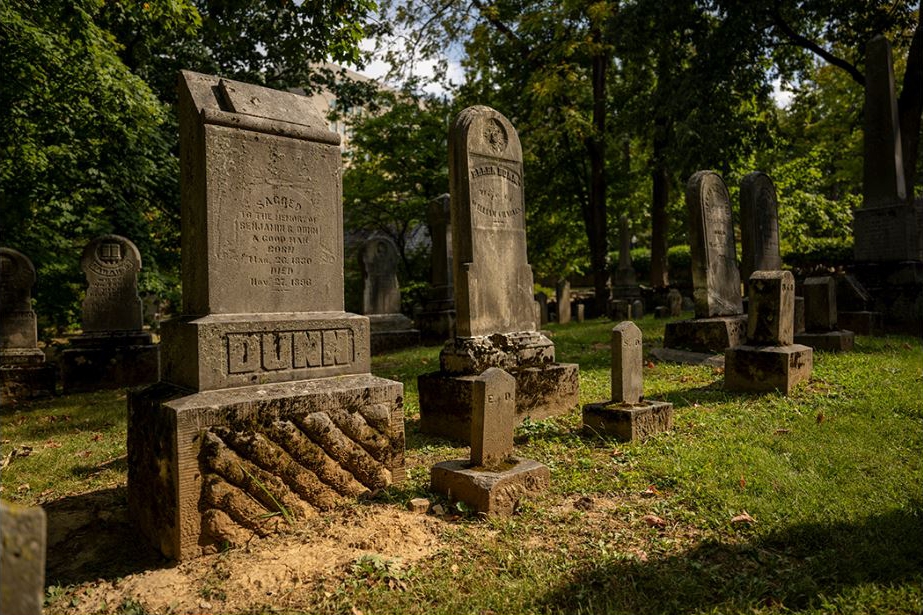The Dunn Cemetery–Indiana University (Part Four)

NOTE:
The following article was originally published in the Fall 2023 edition of the Indiana University Alumni Magazine. Aerlex Law Group founder and President Stephen Hofer is an Indiana alumnus and thought our Aerlex audience might find it of interest, even though it’s definitely “off-topic,” at least as far as business aviation is concerned. This is the fourth and final in a four-part series. If you missed any part of the series, the bottom of this article has links to each of the first three parts. We think you will ultimately be at least a little entertained and charmed by what you’ll learn about the Indiana University campus, a pioneer graveyard, Revolutionary War patriots and the founder of our firm.
By Deborah Galyan
Early Influencers
Long before social media gave us the term, members of the Dunn and Brewster families were influencers who made groundbreaking contributions to state and national politics, particularly in the realm of higher education. “I think there has always been a strong and meaningful connection to higher education—and that stretches back over the generations to a time when college attendance was quite rare,” Hofer says.
 One standout is David Hervey Maxwell (1786–1854), who married into the Dunn family in 1809. Maxwell was a principal author of Indiana’s first constitution and a long-serving statesman. He is often called the “Father of Indiana University” for his legislative role in the creation of the Indiana State Seminary—IU’s earliest precursor.
One standout is David Hervey Maxwell (1786–1854), who married into the Dunn family in 1809. Maxwell was a principal author of Indiana’s first constitution and a long-serving statesman. He is often called the “Father of Indiana University” for his legislative role in the creation of the Indiana State Seminary—IU’s earliest precursor.
George Grundy Dunn Sr. (1812–1857) is another case in point, but his story comes with a twist. Dunn, who wrote the cemetery’s deed, was a talented lawyer who served two terms in the U.S. Congress and one as an Indiana state senator. He was among the first students to attend what would become Indiana University—but things did not go well, according to family accounts. After a serious argument with his professor, he left the school in his third year without graduating. The nature of the conflict isn’t known, but it seems to have alienated him from both IU and Bloomington. It might explain why, ironically, George is not buried in the cemetery that he formally established, but instead was laid to rest in Bedford, Ind.
Forever Entwined

Knowing that a thirst for education is part of the family DNA makes the little cemetery, folded into the heart of the campus, perfectly placed.
The words of one of Samuel and Elizabeth’s granddaughters, Elizabeth (Dunn) Legge (1845–1932), offer a poignant glimpse of what cherished ground the old farm was to the family, and how emotional it must have been when their land and cemetery became forever entwined with IU. Legge composed these words as part of a “remembrance” she presented to the Monroe County Historical Society on May 4, 1906:
“I do not know what year our grandparents moved to Indiana, but I do know that the house at the old Dunn homestead was built in 1823, and the old farm, of which the college grounds are now a part, seems like sacred soil to us, grandchildren, and the little cemetery, surrounded by the college grounds, where so many of our dear ones sleep, was chosen by our grandfather as a burial place soon after they moved there. And we feel that if they could know, they would be pleased with the surroundings just as they are, and would rather our college, of which they were so proud, would be near them, than to have the town built around them, and that the cheers of the students on Jordan Field would disturb them as little as if they were living as it does now.”
Some who pass by the cemetery in the course of a busy day might see it as an oddity, others as an invitation to pause, breathe, or reflect. Genealogists, historians, and poets, perhaps, might see something more: a collection of stories set in stone. Most gravestones speak tersely. A name, some dates, a parting verse or prayer. But the stories of the people resting beneath them are open to anyone willing to follow a trail that begins with little more than a name.
NOTE: This is the end of the series (Part Four). For those of you who missed any of the earlier part of the series, here are the links for parts one, two and three:
Part One: https://www.aerlex.com/cemetery/
Part Two: https://www.aerlex.com/cemetery2/
Part Three: https://www.aerlex.com/cemetery3/
